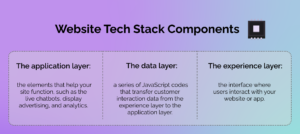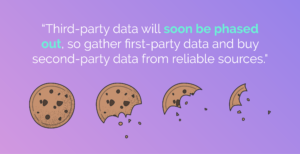Are you ready for the cookieless future? One of the best and most reliable ways to prepare is by collecting first-party data.
First-party data is the data that you collect from your own website about customer behavior, engagement, and interactions.
As third-party cookies phase out over the coming years, businesses that collect large amounts of high-quality data will have the advantage over those that rely only on third-party cookie based data, or compiled through data modelling.
To implement a robust first-party data collection system, you need a data layer — a single platform that stores and organizes your customer data.
A data layer is a reliable means of gathering information and a great way to enrich your web tracking and user personalization opportunities. This can help you optimize your marketing strategy and customer experience to drive more sales.
This article will introduce the data layer — what it is, how it works, how it can help you improve your website analytics — and some best practices for creating a data layer.
What Is a Data Layer?
Have you ever wondered what goes on behind the scenes of your favorite websites? If you’re a marketer, you know the value of data in making informed decisions about your customer’s experience. That’s where the data layer comes in!
A data layer is a collection of one or more JavaScript objects (JSO) that gather and hold all the data on your website that you want to process and pass to other applications or reporting tools — for example, web analytics, heat mapping, and tracking.
The data layer organizes and structures data according to a simple, standard format — regardless of the source of the data — and it ensures that each tool gets the data it needs.
The data layer isn’t a physical layer but rather a series of JavaScript codes. It is one component of your business’s tech stack that comprises:
- The application layer — these are all the elements that help your site function, such as the live chatbots, display advertising, and analytics.
- The experience layer — this is the user interface, where users interact with your website or app.
- The data layer — a data structure that acts as an intermediary between the other two layers, transferring customer interaction data from the experience layer to the application layer.

Not all websites have a data layer, but having one can improve the quality of your data collection and analytics. This is especially important for businesses since they rely on data to improve their performance — particularly as we face the cookieless future.
Without a data layer, it can be difficult to extract valuable customer data that can inform sales decisions and advertising strategies.
For example, without a data layer, it can be difficult for businesses to access valuable customer data from third party payment processing. They may be able to see purchase data, but not the previous touchpoints in the customer journey that led to the sale. A data layer can bridge that gap and provide a more complete picture of the customer experience.
What Does a Data Layer Do?
Put simply, a data layer puts you in control of your most valuable asset — your user data. This is because it allows you to specify what information you want to collect about how visitors use your website.
One of the main reasons businesses use data layers is because they provide a place to store different types of data that might not be possible to access through the experience layer or markup and source code.
A data layer integrates with other tools, improving data quality by providing each tool with the necessary data.
For example, if you use Google Analytics and Google Tag Manager (GTM) for web analytics, a data layer will ensure that each of these tools receives the relevant data.
A data layer also facilitates team alignment with a single, reliable data collection strategy.
Types of data you can store with a data layer include the following. These are only some of the possible examples, though. The DataLayer can be configured to hold any information from the page you want.
- Page names, URLs, and page categories of the pages your customers visit
- Anonymous website visitor information, such as:
- Demographics
- Social information
- Historical information
- User interactions such as:
- Page load
- Page view
- Scrolls
- Clicks
- Exit intent
- Purchase information, such as:
- Product name
- Product IDs
- Product price
- Cart value
- Conversion statistics, such as:
- Conversion value
- Product categories
- Product SKUs
- Total purchase value
- Payment type
- Data from third-party vendors whose applications you use on your website, such as a CRM or live chat services
How The Data Layer Improves Analytics
Still not sure if you need a data layer? Here are five benefits for your business that might convince you.
1. A Data Layer Streamlines Data Collection
A data layer expedites and standardizes the data collection process, thereby increasing efficiency. This is because it centralizes the collection of data through your website and its distribution to your marketing tools.
This makes it more reliable, consistent, and faster than collecting data from each of your vendors.
Therefore, a data layer is one the simplest and most streamlined ways to feed customer data into platforms like GTM.
2. You Can Customize Your Data Collection
Data layers make it easier to customize the way you track user behavior on your website.
For example, if you want to run segmented remarketing campaigns, you can collect and analyze data to create different audience profiles and target each of them according to their behavior.
3. A Data Layer Makes Custom Tracking Easier
A data layer makes it easier to implement custom tracking. For example, say you’re using Google Tag Manager and want to implement Google Analytics e-commerce tracking.
Once you add the relevant information from GTM to the data layer, it can fetch this information and transfer it to Google Analytics.
4. A Data Layer Helps You Understand Your Customers
Collecting data through a data layer can tell you a lot about your customers, including their interests, desires, problems, pain points, and needs.
A data layer helps you understand customer behavior across multiple channels, thus improving your analytics.

5. A Data Layer Adapts to Your Needs
A data layer has the flexibility to optimize your data analysis in any way that makes sense for your business.
For example, as your business grows, a value that was previously necessary may become less relevant and be superseded by another, more important piece of data.
If this happens, you can remove the less relevant value and add in the new metrics.
Best Practices For Implementing A Data Layer
Ready to create a data layer for your website? Use these best practices to set yourself up for success.
Decide What Data to Analyze
Websites are increasingly complex, with a multitude of data and tracking requirements, so it’s important to decide what data you want to analyze and thoroughly plan the data points you’re going to expose through your data layer.
For example, you can identify which of your vendors or business tools need data. This will help you maintain your data models and ensure accurate data.
Organize Your Data
To keep your data organized, you’ll need to determine the data layer structure and naming conventions.
Some tag management systems like GTM or Adobe Launch have default data layer conventions that simplify the process. However, you can also opt to customize your names and structures.
Since the data layer is used by multiple teams — such as data analysts, digital marketers, and developers — you’ll need to test your data layer regularly to minimize the effects of human error and maintain the integrity of your data.
Remove Any Other Data-Gathering Programs
Remove any vendor-specific DOM-scraping or other data gathering from your website pages, templates, and header.
Decide on a Data Governance Plan
Your website and the data layer are going to change, so think about how to maintain the data, improve it, and track it over time.
Add an Event Name to the Data Layer Push
When you execute your data layer push, make sure you add a custom event name. This is essential, as it will be used as a trigger in Google Tag Manager. The event name is what allows you to create a trigger for any tag of your choosing.
Audit Your Data Layer Regularly
Perform regular audits to verify that your data layer is functioning as expected. For instance, you will need to verify that:
- The data layer is populating correctly on page load and on each triggered event.
- The appropriate key-value pairs are present in the data layer and in the right format.

Improve Your Advertising Campaigns with a Data Layer
A data layer allows businesses to access, gather, and track a wealth of data about their users across a wide variety of channels. When implemented well, a data layer can help you improve your user experience and optimize your advertising strategies by providing rich, reliable customer data.
However, setting up data layers takes time to plan and implement and requires robust knowledge. That’s why many advertisers partner with Grapeseed and our team of adtech experts — including data layer specialists.
Get in touch with the Grapeseed team to learn more about how data layers work and how you can use them to improve analytics and grow your business.






